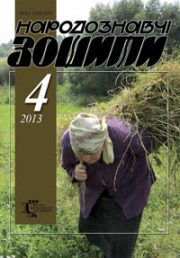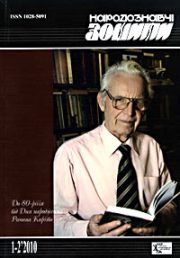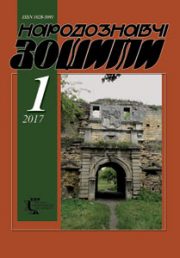The Ethnology Notebooks. 2022. № 4 (166), 827—835
UDK 392.1(161.2:292.451/.453):582.091
DOI https://doi.org/10.15407/nz2022.04.827
A TREE IN THE BIRTH RITE OF UKRAINIANS OF THE CARPATHIANS
NAKONECHNA (HOSHCHITSKA) Tetiana
- ORCID ID: https://orcid.org/0000-0001-8596-8974
- Doctor of Philosophy, researcher fellow
- of department of Historical Ethnology
- of the Institute of Ethnology The National
- Academy of Sciences of Ukraine,
- 15, Svobody Avenue, 79000, Lviv, Ukraine,
- Contacts: e-mail: hoshchitska.tetiana@gmail.com
Abstract. Introduction: The rituals of the traditional birth ceremony of the Carpathian Ukrainians constitute a complex of customs and beliefs, in which protective motives and efforts to ensure the fertility of the child in the future were dominant. Problem Statement: In this part of the ritual culture, beliefs related to trees were reflected and alloforms of the ritual tree were used. First of all, such an interesting relic of the pre-Christian worldview as the symbolic correlation of a child and a tree, a certain «anthropomorphization» of it, and an attempt to transfer some of its qualities to a child attract attention. Unfortunately, this aspect, as well as the alloform of the tree, which is also present in the birth rites of the Carpathian Ukrainians, has not yet attracted the attention of researchers, while it is an interesting page of the ancient beliefs of our ancestors, and contains significant research potential. The purpose of the article is to systematize the available information about these phenomena, study the peculiarities of their functioning, state of preservation, and attempt to clarify their semantics The object of the study is the traditional birth rites of the Ukrainian highlanders, the subject is the functioning of alloforms of the ritual tree and various beliefs related to trees, which in one way or another were reflected in the traditional birth rites of the Ukrainian Carpathians. The main methods used by the author are structural and comparative. Results: Beliefs related to trees and alloforms of trees in this area of the ritual were studied. Conclusion: The symbol of the tree in the birth ritual, in comparison with other parts of the life cycle ritual, is expressed the least. But in this case, we see clearly expressed ideas about the anthropomorphic nature of the tree, the correlation of the child, its growth and the tree, which was manifested in the recorded customs of planting a tree in honor of the birth of a child, and in the belief that certain families trace their lineage from the tree. Also, under the tree as a symbolic «mediator» between the worlds, the first baptismal font was poured, and sometimes the placenta was buried. We also traced the life of the alloform of the tree — the wedding braid.
Keywords: birth rites, rite tree, Ukrainian Carpathians, family rites, fights, Lemkos, Hutsuls.
Received 4.08.2022
REFERENCES
- Sen’kiv, I. (1995). Hutsul heritage. Works about life and art of Hutsuls. Кyiv: Ukrainoznavstvo [in Ukrainian].
- Gvozdevuch, S. (2002). Maternity customs and rites. In: Lemkivshchyna (Vol. 2, pp. 64—74) [in Ukrainian].
- Ganus, D.M. (2015). A child in the system of folk beliefs and rituals of the population of the Ukrainian-Polish border (Dissertation). Ivan Krypiakevych Institute of Ukrainian Studies of the National Academy of Sciences of Ukraine [in Ukrainian].
- Darmits, R. (2012). Folk hygienic knowledge and beliefs related to the birth and upbringing of a child (based on the materials of rural life in the Carpathians). In: Bulletin of Lviv University. The series is historical (Issue 47, рр. 123—141) [in Ukrainian].
- Tarnovych, Yu. (1941). Lemkivschyna. Material culture. Krakow [in Ukrainian]
- Falkowski, J. (1937). On the west border of Hutsylshchuna: on the wallej of Prut, Bystrzyca Nadwornianska, Bystrzyca Solotwinkia i Lomnica. Lviv [in Polish].
- Bojko, N. (2008). Field materials before topic of «MATERNITY RITE» from the expedition to the Bohorodchans’kyj district, Ivano-Frankivs’koi area, 11—24.07.2008). In Archive of the HF LNU. F. 119. Op. 17. Od. save 244-E. Arc. 1—67 [in Ukrainian].
- Onischuk, А. (1909). Materials to the Hutsul demonology, written in 1907—1908 in Zelenitsy, Nadvirna district by Antin Onischuk, the folk teacher. Materiialy do ukrains’koi etnol’ohii (Vol. ХІ, pp. 1—139) [in Ukrainian].
- Kuilichi, F., & Gvozdetskyi, M.A. (Ed.). (1973). In pygmies. Textbook of physical geography. Africa. Australia. Oceania. Antactite America (Pр. 105—107) [in Ukrainian].
- Chori, Yu. (2003). Plant and animal wonderland (Legends, legends and stories about fauna and flora). Mukachevo [in Ukrainian].
- Tivodar, M.P. (2005). Life and scientific research of Fyodor Potushniak. Uzhhorod: Hrazdha [in Ukrainian].
- Boyko, V.G. (Ed.). (1962). Ukrainian children’s folklore. Kyiv: Institute of Art History, Folklore and Ethnography [in Ukrainian].
- Zelenyn, D.K. (1937). Totem trees in the legends and rituals of the European peoples. Моscow; Leningrad: Izdatel’stvo AN SSSR [in Russian].
- (1989).Marriage among the peoples of Western and Southern Europe. Moscow: Nauka [in Russian].
- Svitlyk, P.M. (2008). The Heavenly Spring: Transcarpathian folk tales, legends, beliefs, customs, traditions, everyday life. Uzhgorod: Hrazdha [in Ukrainian].
- Warhol, Y. (2019). Calendar and family rituals of Ukrainians in Slovakia. Kyiv: IMFE [in Ukrainian].
- Warhol, N. (1992) People’s imagination about a tree. In: Scientific collection of the Museum of Ukrainian Culture in Svydnik (Issue 18, рр. 228—244) [in Ukrainian].
- (2016). Ethnographic image of modern Ukraine. Corpus of expeditionary ethnographic and folklore materials (Vol. 3: Birth ritual). Kyiv: IMFE [in Ukrainian].
- Mushinka, M. (2008). Family and household rites of the village of Kurov, Bardeevsky district (birth, baptismal and wedding customs and ceremonies). From the father’s threshold. Collected works (Vol. 1, pp. 499—586) [in Ukrainian].
- Gavrilyuk, N. (1981). Mapping of cultural phenomena (based on the materials of Ukrainian birth rites). Kyiv: Naykova dymka [in Russian].
- Horoshko-Pohoretska, L. (2019). «In order to unite with the child» (birth cycle of birth rites of residents of Pokuttia). The ethnology notebooks, 2, 346—353. DOI: https://doi.org/10.15407/nz2019.02.346 [in Ukrainian].
- Voitovich, N. (2015). Folk Demonology of Boykivshchyna. Lviv [in Ukrainian].
- Digital archiv SHKR «Tustan». Оd. save. 101 (Photographs by Ivan Shveda) [in Ukrainian].
- Serebryakova, O. (2018). Ritual use of water in the Christmas and Epiphany rituals of Pokuttia residents. The ethnology notebooks, 3, 577—585. DOI: https://doi.org/10.15407/nz2018.03.577 [in Ukrainian].
- Goisak, V. (2010). The linguistic picture of the world reflected in folk carols from Lemkivshchyna. Horlyts [in Ukrainian].
- Vincent, S. (2011). On a high mountain. Ivano-Frankivsk: Lileja-NV [in Ukrainian].
- Lintour, P. (Ed.). (1965). Tales of green mountains. Uzhhorod [in Ukrainian].
- Lintour, P. (Ed.). (1969). Dido-omniscient. Transcarpathian folk tales. Uzhhorod: Carpathians [in Ukrainian].
- Rakhno, K. (2019). Pottery in the folklore heritage of Ivan Franko. The ethnology notebooks, 3, 563—579 [in Ukrainian].
- Oldhouse-Green, M. (2020). Celtic myths. From King Arthur and Deirdre to the Fayre and the Druids. Moscow: Mann, Ivanov and Ferber [in Russian].
- Bardavelidze, V.V. (2006). Ancient religious beliefs and ceremonial graphic art of Georgian tribes. Tbilisi: Caucasian House [in Russian].
- Reinfuss, R. (2015). Тhe Carpathian world of Boykiv and Lemkiv. Foto. Lesko [in Polish].
- Ivanytsky, A.I. (Ed.). (2013). Songs from families and baptisms (collection-reconstruction with theoretical exploration, comments, models of rhythmic structure, indexes). Vinnytsia: New Book [in Ukrainian].
- Bryniak, O. (2011). Rudiments of mythological beliefs in maternity rites and baptismal poetry of Ukrainians. The ethnology notebooks, 3 (99), 426—435 [in Ukrainian].
- Dovzheniuk, H. (2008). Children and song folklore. Folk culture of Ukrainians: human life cycle: historical and ethnographic research (Vol. 1, pp. 117—136) [in Ukrainian].
- Derlytsia, M. (Ed.). (1898). Peasant children. Ethnographic essay, written by M. Derlytsia. Ethnographic collection (Issue 5, pp. 121—140) [in Ukrainian].
- Sokil, V., & Sokil, H. (1998). Folklore materials from the fatherland. Lviv [in Ukrainian].






